The Effect of Canopy Area on Ripening and Wine Quality in Merlot (2018)
Justin Rose
Rosemont of Virginia
Abstract
Rosemont of Virginia experiences high heat and fast ripening in Merlot leaving less time for phenolic maturation. Hedging of vines, in addition to preventing adverse effects of shading, can also slow ripening due to decreased photosynthetic surface area. The purpose of this trial was to examine the effects of three hedging heights on the ripening kinetics, resulting grape and wine chemistry, and sensory properties. Vines were hedged to 36, 44, or 52 inches beginning in early June. Hedging heights were maintained through harvest. Short canopy vines showed delays in veraison and ripening, allowing for a later harvest in the short canopy treatment. These vines had lower yield than medium or high canopy treatments. Fruit from short canopy treatment had higher YAN, higher brix (due to later harvest) and higher pH. Resulting wines showed an increase in potassium and pH with diminishing canopy height. Short canopy wines had lower anthocyanin concentration but higher concentration of seed phenolics. There were no significant sensory differences among these wines.
Introduction
Growing conditions in Virginia often lead to high vigor canopies. These high vigor, high density canopies can cause a number of problems in the vineyard and the winery. High vigor canopies often contain inner leaves that do not receive adequate sunlight such that they become carbohydrate sinks rather than sources(1). Densely shaded canopies have higher incidence of disease due to poor air flow and poor spray penetration. Shading of developing buds for the following year can lead to fewer inflorescences per shoot (2), smaller clusters and reduced berry set (1). Shaded fruit can also have higher potassium, pH and TA as well as reduced phenolic compounds, pigments, varietal flavor, and overall sugar accumulation (1). Shading can also lead to higher levels of compounds that produce vegetal flavors such as methoxypyrazine and C6 alcohols (1, 2). By contrast, open canopies in general lead to higher sugar, color, and positive aroma compounds such as nor-isoprenoids (which lead to varietal character in aromatic white wines) and terpenes (which contribute floral, Muscat-like aromas to wine) (2).
Hedging is one of many approaches to deal with vigorous vine growth, but the severity and timing of hedging matters. Hedging includes the removal of primary and lateral shoot growth from the top and sides of the canopy. This operation is done to prevent shading and entanglement of shoots between vine rows, and to maintain adequate light exposure to leaves, fruit and developing buds that would otherwise be shaded (2). When hedging, care must be taken to retain adequate leaf area to fuel photosynthesis for the remaining plant and its fruit. The Wine Grape Grower’s Guide (1) recommends that at least 15 leaves should remain after leaf removal to allow adequit photosynthetic activity for the production of sugar and development of winter hardiness (1). Hedging can also stimulate lateral shoot growth, which can compete with ripening fruit for sugar.
Several studies have examined the effects of hedging on vine and fruit parameters. In 1989, Reynolds and Wardle (3) studied the effects of hedging to 5, 10, and 15 remaining leaves at post-bloom, lag phase, and veraison in de Chaunac. They found that light exposure was highest for the vines with the fewest (5) leaves, though not different for vines with 10 and 15 leaves, and that removal of canopy did improve cluster exposure. They hypothesize that most of the leaves removed post bloom were likely photosynthetic sinks, which explains why their removal caused little difference in most of the vine metrics. They conclude that high vigor vineyards may benefit from severe early hedging in terms of light environment and canopy density with minimal reductions in vigor and cold hardiness, but caution that continued severe hedging could lead to vine stress over time. This study did not look at fruit quality.
In 2012, Coniberti et al (4) conducted a study of partial defoliation of Tannat in Uruguay. They compared several approaches to opening the canopy including 33% canopy defoliation, lateral shoot thinning, and hedging to 30 cm above the top wire. Like Virginia, Uruguay has high soil fertility, high vine vigor, and high potassium availability. This region also has high humidity and experiences rain during the growing season. They found that partial defoliation in shaded canopies significantly reduced potassium accumulation and wine pH without negatively affecting brix, acids, anthocyanin or phenolics. In the three years of the study, one year was a “dry” season relative to the others. In this season, potassium levels in the control rivaled those in the defoliation treatments in the other two years, though the trend of lower potassium in defoliated vines was consistent. They also found that vintage had a larger effect on potassium levels than any of the treatments.
In a study of defoliation by leaf pulling in Chardonnay in Virginia, Silvia Leiggieri (2019)(5) found consistently lower disease severity with leaf pulling of 3 and 6 leaves near the fruit zone, fewer berries per cluster, and higher free norisoprenoids, though total norisoprenoids decreased with leaf pulling. In a similar study in Cabernet Sauvignon, she also examined effects of hedging to 50 vs. 32 inches. Once again disease incidence decreased with defoliation (by hedging or leaf removal), however effects on grape chemistry were mixed. The only significant effects of hedging on grape chemistry were an increase in pH and decrease in anthocyanin in 2017; there was no difference in pH in 2018 and anthocyanin were not reported. Hedging had a negative effect on bound and total norisoprenoids, though free norisoprenoids increased with hedging.
In the present study, vines were hedged to three heights (36, 44, and 52 inches) at Rosemont of Virginia, LaCrosse. This vineyard is located in Southern Virginia and experiences high temperatures that lead to rapid brix accumulation and less time for adequate phenolic development in red wine grapes. The aim of severe hedging at Rosemont was to delay brix accumulation to allow longer time for phenolic development and increased structure in the resulting wines. This approach was first applied in 2017 and was repeated in 2018.
Protocol
Fifteen rows of Merlot (clone 343 on RG rootstock) with VSP trellising were divided into three blocks of five rows each. After fruit set, each block was hedged to different heights beginning in early June and continuing through the remainder of the growing season. Hedging heights were:
52 inches (“high")
44 Inches (“medium”, corresponding to the top of the third wire)
36 inches (“short”, located between the second and third wire)
To maintain hedging heights, medium and high canopy trials were hedged a total of twice while short canopy was hedged a total of three times.
Parameters of the study were the same as those used in 2017. The same rows received the same treatment each year.
Grapes were harvested at a common target of 22 Brix based on vineyard fruit sampling. Medium and high canopy treatments were harvested on September 2 while the short canopy treatment was harvested on September 7.
After harvest, grapes were refrigerated overnight, destemmed and lightly crushed into Tbins with the addition of 50 ppm SO2, 30 g/hL Tanin VR Supra, 40 g/ton HE Grand Cru. No bleeds were done for the experiment. Grapes were cold soaked for 4 days at 50 degrees. Bins were inoculated with 25 g/hL FX10 yeast rehydrated in 30 g/hL Superstart Rouge. At the beginning of fermentation, 15 g/L VR Supra and 1 g/L tartaric acid were added. Nutristart Org (30 g/hL) was added at ⅓ brix depletion. Winemaking procedures were kept same for each treatment except nutrient additions. Medium and high canopy treatments received 15 g/L Thizote. No nutrients were added to the short canopy treatment, as YAN was above the target (Table 2).
Fermentations were allowed to warm naturally, but when temperatures approach 85 degrees, they were moved to a 55 degree warehouse. This occurred on day 3 of the fermentation for both medium and short canopy treatments but was not needed for the high canopy treatment. Bins were punched down 2-3 times per day at the beginning of fermentation through peak fermentation. Once fermentation slowed, one punch down per day was done until fermentations were dry. Bins were pressed when dry and inoculated for malolactic fermentation. Malic acid depletion was monitored with paper chromatography. At the end of malolactic fermentation, 50 ppm SO2 was added with further additions one week later to achieve a target of 35-40 ppm free SO2. Wine was aged on lees until samples were taken for sensory analysis.
Sensory analysis was completed by a panel of 26 wine producers. Wines were presented blind in randomly numbered glasses. Panelists were asked to rank the wines in order of preference, then score each wine on a scale of 0 to 10 for color, fruit intensity, bitterness and astringency. Panelists were also given open ended questions to describe the wines.
Results
The ripening curves for each canopy treatment are shown in Figure 1. Table 1 summarizes ripening parameters. The short canopy treatment went through veraison later than the medium or tall canopy treatments and appeared to ripen slower during the period of Aug 18 through 31. The shorter canopy vines produced lower yields with considerably higher YAN relative to the other treatments (Table 1, Table 2).
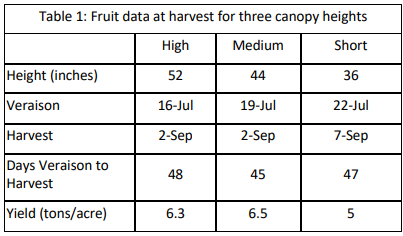
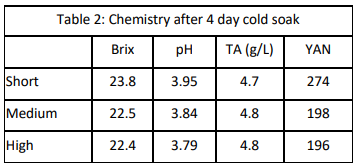
All fermentations progressed steadily (Figure 2). High and medium canopy treatments were pressed 10 days after inoculation. Short canopy treatment was pressed 11 days after inoculation.
Short canopy had higher brix at harvest, leading to higher alcohol in the wine. Medium and high canopy treatments produced juice of similar sugar and alcohol levels. pH level increased with decreasing canopy height in both juice (Table 2) and wine (Table 3). Potassium levels in the wine also increased with decreasing canopy height (Table 3, Figure 3).
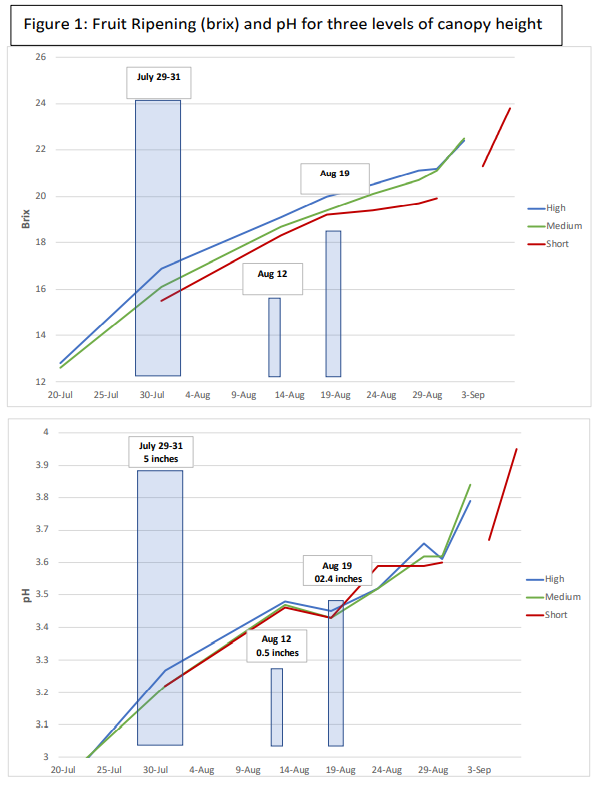

Wine color and phenolics
There was no strong trend in wine color among treatments, with overall low Intensity (ETS labs considers an intensity of 1-6 is considered a “lightly colored wine”) and high hue (Table 4). Total anthocyanins are within a normal range, with the short canopy having the lowest level of anthocyanins (Table 5, Figure 4). That trend is reversed for other phenolics (Table 6, Figure 5). The short canopy produced higher seed phenolics and higher level of tannins, though all of these differences are very slight.

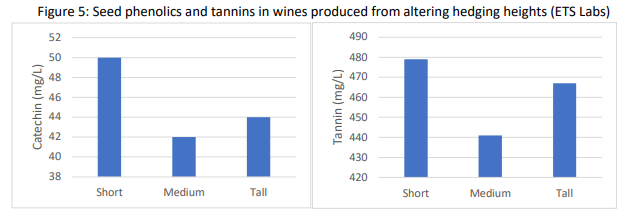
Sensory analysis
Sensory analysis of these wines in March of 2018 showed no significant preferences (11, 9, and 6 for short, medium, and tall). When tasters were asked to score descriptors of color, fruit intensity, astringency and bitterness, none were significantly different. This indicates that though anthocyanin concentration was lower, there was not a significantly different perception of color at this time.
Conclusion
As expected, severed hedging slowed veraison, brix accumulation and decreased yield in both 2017 and 2018. In 2018, fruit from the short canopy treatment had higher nutrients overall, as seen in higher YAN and potassium numbers. Though higher YAN may be positive, higher potassium is concerning due to its affect on pH. There were slight increases in seed phenolics in the shorter canopy wine, but this wine also had lower anthocyanins. There were no significant differences in sensory descriptors among the wines, and no significant preference for one wine over another.
Comparison of 2017 and 2018
This is the second year of hedging at Rosemont. Each year, the same rows have been hedged to tehir respective treatment heights. Table 7 summarizes some comparisons from this trial in 2017 and 2018.
- Growing conditions: 2017 and 2018 were very different growing seasons, with 2017 showing an average rainfall of 18.3 inches from April through August with a total of 4000 average degree days while 2018 showed 34.7 inches (Table 3). Despite the rain n 2018, there were 4257 average degree days.
- Harvest date: Fruit was harvested a full 10 days later in 2018 for medium and high canopy trials, and 15 days later for short canopy trials. Unlike 2017, trials were not harvested on the same day, as brix and pH levels were more varied.
- Yield: In both 2017 and 2018 short canopy treatments yielded fewer tons per acre, with a larger difference in 2018 than 2017. Short canopy treatments also yielded fruit with higher brix both years.
- Ripening kinetics: Short canopy ripening curves were delayed in both years with slower brix accumulation prior to the last few days before harvest. However, this did not result in a longer hang time relative to veraison either year.
- pH: pH effects of hedging height were not consistent from year to year, with no effect in 2017 and higher pH for shorter canopy in 2018. This may have been due to longer hang time rather than the canopy effect itself.
- Potassium in wine: Effect on potassium level was also not consistent, with no consistent effect in 2017 but a large effect in 2018. Plant potassium is partially dependent on water availability, so the disparity between 2017 (relatively dry) and 2018 (very wet), likely led to more uptake of potassium overall in 2018. (Potassium levels in wine ranged from 1100-1150 in 2017 while in 2018 they ranged from 1254-1548). This increase in potassium may also be affecting pH, as higher potassium wines also had higher pH and lower TA. However, the effect of canopy height on relative potassium in 2018 is concerning.
- Color: In 2017, hedging increased wine color intensity, as seen in absorbance numbers and in the concentration of anthocyanins. In 2018, the short canopy had lower anthocyanins and average intensity. Once again, this may be due to longer hang time, as anthocyanins decrease over time.
- Phenolics: In 2017 most phenolics were the same among treatments, with a small increase in tannin in the short canopy treatment. In 2018, the short canopy produced slightly higher seed phenolics and tannins. Again, this effect is consistent with longer hang time.
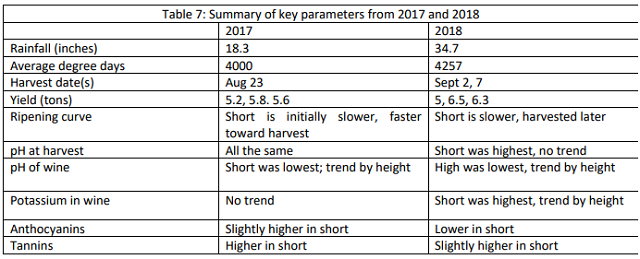
References
- Wine Grape Production Guide for Eastern North America. 2008. Tony K Wolf, Editor. Natural Resource, Agriculture, and Engineering Service.
- Vance, A.J, Reeve, A. L., Skinkis, P.A. 2013. The Role of Canopy Management in Vine Balance. OSU Extension catalog, Oregon State University Extension Service.
- Reynolds, A. and Wardle, D. 1989. Effects of Timing and Severity of summer hedging on growth, yield, fruit composition, and canopy characteristics of de Chaunac. I. Canopy Characteristics and growth parameters. AJEV 40 (2):109-120
- Coniberti, A, Ferrari, V, Farina, L, Carrau, F, Delacassa, E., Boido, E., and Disegna, E. 2012. Role of Canopy Management in Controlling High pH in Tannat Grapes and Wines Am. J. Enol. Vitic. 63:4.
- Liggieri, S. (2017, February) Fruit Exposure Impact on Grape Aroma Development. Paper presented at Virginia Viticulture Association Winter Technical Meeting, Charlottesville, Virginia.
